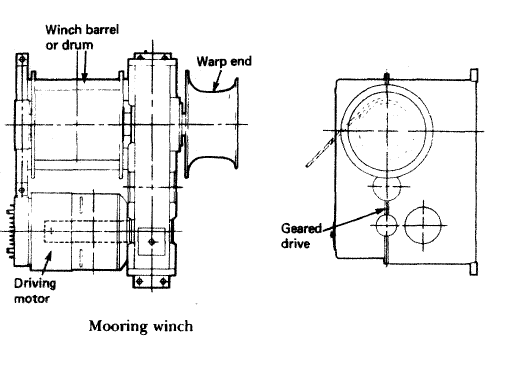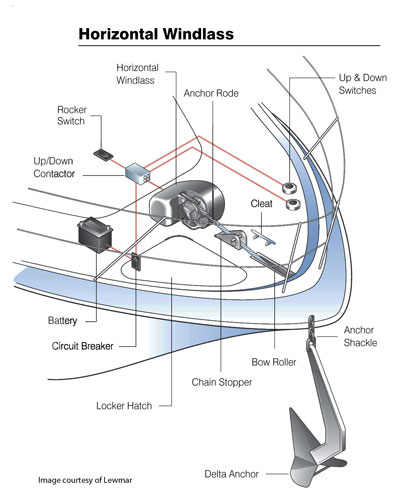Purpose of Deck Mooring Winch and Windlass Winch used on board ship:
Deck Mooring Winch:-

- Mooring winch is a mechanical device used for securing a ship to the berth. An equipment with various barrels used for pulling ropes or cables, mooring winches play an important role in berthing the ship ashore.
- The barrels, also known as winch drums, are used for hauling in or letting out the wires or ropes, which will help in fastening the ship to the berth.
- Mooring winches assembly comes in various arrangements with different number of barrels, depending on the requirement of the ship.
- The main parts of mooring winch includes a winch barrel or a drum, a warp end and a driving motor. Modern mooring winches comprises of elaborate designs with various gear assemblies, which can be electric, pneumatic or hydraulic driven.
Windlass Winch:-

- A windlass is a machine used on ships that is used to let-out and heave-up equipment such as a ship’s anchor or a fishing trawl. On some ships, it may be located in a specific room called the windlass room.
- An anchor windlass is a machine that restrains and manipulates the anchor chain on a boat, allowing the anchor to be raised and lowered by means of chain cable. A notched wheel engages the links of the chain or the rope.
- A trawl windlass is a similar machine that restrains or manipulates the trawl on a commercial fishing vessel. The trawl is a sort of big fishing net that is wound on the windlass.
The fishermen either let-out the trawl or heave-up the trawl during fishing operations. A brake is provided for additional control. The windlass is usually powered by an electric or hydraulic motor operating via a gear train. - Technically speaking, the term “windlass” refers only to horizontal winches. Vertical designs are correctly called capstans. Horizontal windlasses make use of an integral gearbox and motor assembly, all typically located above-deck, with a horizontal shaft through the unit and wheels for chain and/or rope on either side.
Vertical capstans use a vertical shaft, with the motor and gearbox situated below the winch unit (usually below decks).
Q) List the routine maintenances carried out on board.
Ans:- Efficient planning and adequate usage of equipments is the key to productive maintenance.
Types of Maintenance Procedures:-
- Preventive or Scheduled Maintenance System: – It is famously known as the PMS or Planned Maintenance System. In this type of system the maintenance is carried out as per the running hours like 4000 hrs, 8000 hrs etc., or by the calendar intervals like 6 monthly, yearly etc. of the machinery. The maintenance is carried out irrespective of the condition of the machinery. The parts have to be replaced if it is written in the schedule, even if they can be still used.
- Corrective or Breakdown Maintenance: – In this system the maintenance is carried out when the machinery breaks down. This is the reason it is known as the breakdown maintenance. This is not a suitable and good method as situations may occur wherein the machinery is required in emergency. The only advantage of this system is that the working of machinery parts is used to its full life or until it breaks. This system might get costly as during breakdown several other parts may also get damaged.
- Condition Maintenance system: – In this system the machinery parts are checked regularly. With the help of sensors etc. the condition of the machinery is accessed regularly and the maintenance is done accordingly. This system requires experience and knowledge as wrong interpretation may damage the machinery and lead to costly repairs which may not be acceptable by the company.
